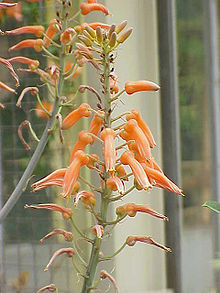Aloe lateritia
| Aloe lateritia | ||||||||||||
|---|---|---|---|---|---|---|---|---|---|---|---|---|

Aloe lateritia |
||||||||||||
| Systematics | ||||||||||||
|
||||||||||||
| Scientific name | ||||||||||||
| Aloe lateritia | ||||||||||||
| Engl. |
Aloe lateritia is a species of aloes in the subfamily of the Affodilla family (Asphodeloideae). The specific epithet lateritia comes from Latin , means '(dark) brick red' and refers to the color of the flowers.
description
Vegetative characteristics
Aloe lateritia grows stemless and is usually simple. Sometimes the species sprouts and then forms small groups. The 16 to 20 lanceolate, narrowed leaves form dense rosettes . The bright green leaf blade is 25 to 50 inches long and 5 to 10 inches wide. On it there are usually elongated, white spots that are arranged in irregular transverse bands. The leaf surface is smooth. The stinging, brown teeth on the leaf margin are 3 to 4 millimeters long and 10 to 15 millimeters apart.
Inflorescences and flowers
The inflorescence consists of three to eight branches and reaches a length of up to 125 centimeters. The dense, heady or almost heady grapes are 4 to 12 inches long and 8 inches wide. Sometimes the grapes are loose and up to eight inches long. The linear-lanceolate bracts have a length of 10 to 20 millimeters (rarely up to 25 millimeters) and are 4 millimeters wide. The orange-red, occasionally yellow, usually shiny flowers are on 20 to 30 millimeter long peduncles . The flowers are 30 to 38 millimeters long and truncated at their base. At the level of the ovary , the flowers have a diameter of 8 to 10 millimeters. Above this they are suddenly narrowed to about 5 millimeters and finally widened to the mouth. Your outer tepals are not fused together over a length of 10 to 13 millimeters. The stamens and the stylus barely protrude from the flower.
genetics
The number of chromosomes in both varieties is .
Systematics and distribution
Aloe lateritia is common in Ethiopia , Kenya and Tanzania .
The first description by Adolf Engler was published in 1895. A distinction is made between the following varieties :
- Aloe lateritia var. Lateritia
- Aloe lateritia var. Graminicola (Reynolds) S. Carter
Aloe lateritia var. Lateritia
The variety is common in Tanzania and in the south of Kenya on grasslands and open bushland, often on rocky slopes at heights of 250 to 2125 meters. The following taxa were included as synonymous in the variety: Aloe boehmii Engl. (1895) , Aloe campylosiphon A.Berger (1904) and Aloe amanensis A.Berger (1905) .
Aloe lateritia var. Graminicola
The differences to Aloe lateritia var. Lateritia are: The variety grows stemless or very short stem-forming, usually sprouts and forms dense clumps. The trunks are up to 50 centimeters long. The teeth on the leaf margin are more piercing. The flower clusters are always head-shaped.
The first description as Aloe graminicola by Gilbert Westacott Reynolds was published in 1953. Susan Carter introduced the species in 1994 as a variety to Aloe lateritia . Aloe solaiana Christian (1940) was included as a synonym in the variety. Aloe lateritia var. Graminicola is common in Ethiopia and Kenya in grassland and open scrubland at altitudes of 1675 to 2530 meters.
proof
literature
- Susan Carter , John J. Lavranos , Leonard E. Newton , Colin C. Walker : Aloes. The definitive guide . Kew Publishing, Royal Botanic Gardens, Kew 2011, ISBN 978-1-84246-439-7 , pp. 179-181 .
- Leonard Eric Newton: Aloe lateritia . In: Urs Eggli (Hrsg.): Succulent lexicon. Monocotyledons . Eugen Ulmer, Stuttgart 2001, ISBN 3-8001-3662-7 , pp. 151 .
Individual evidence
- ↑ Urs Eggli, Leonard E. Newton: Etymological Dictionary of Succulent Plant Names . Springer, Berlin / Heidelberg 2010, ISBN 978-3-642-05597-3 , p. 133.
- ↑ Adolf Engler (Ed.): Plant world of East Africa and the neighboring areas . Part C, 1895, pp. 140-141 (on- line ).
- ^ Journal of South African Botany . Volume 19, Kirstenbosch 1953. p. 9.
- ^ Susan Carter: Flora of Tropical East Africa. Aloaceae . 1994, p. 17.
Web links
- Photo from the inflorescence of the variety Aloe lateritia var. Graminicola

